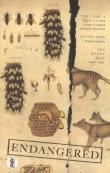AustLit
The material on this page is available to AustLit subscribers. If you are a subscriber or are from a subscribing organisation, please log in to gain full access. To explore options for subscribing to this unique teaching, research, and publishing resource for Australian culture and storytelling, please contact us or find out more.
Latest Issues
AbstractHistoryArchive Description
'They Saw a Thylacine: Out of the darkness, Sarah Hamilton and Justine Campbell conjure the ghost of one of Australia's lost beauties, the thylacine. With all the suspense of a campfire story, these feisty, funny women weave a lyrical tale of adversity and extinction. For this thylacine tracker and this zoo keeper's daughter, it's a quest not just to protect a threatened creature, but themselves. Rebellious and gutsy, these women face life and fight to survive.' (Publication summary)
Affiliation Notes
-
Thylacines and the Anthropocene
This work is affiliated with the Thylacines and the Anthropocene dataset, tracking thylacine extinction and ecological themes in Australian literature.
Production Details
-
Performed at the Melbourne Fringe Festival in 2013.
Later toured by Human Animal Exchange in 2015, with the following cast and crew:
Presented by Performing Lines.
Artistic Collaborator: Matthew Lutton.
Set and Lighting Design: Matthew Adey.
Sound Design: Jethro Woodward.
Costume Design: Chloe Greaves.
Cast: Justine Campbell and Sarah Hamilton.
Publication Details of Only Known VersionEarliest 2 Known Versions of
Works about this Work
-
'Beauty Tigress Queen' : Staging the Thylacine in a Theatre of Species
2015
single work
criticism
— Appears in: JASAL , vol. 15 no. 2 2015; 'Awareness of non-human species, both plant and animal, has lagged well behind theatre’s primary focus on the human drama. The associated human/nature and culture/nature binary oppositions play out in theatre as character and setting, as metaphor and as landscapes of the human mind. In the modern era, theatre that aspires to be political or efficacious, or that believes itself to have a transformative effect on human consciousness, typically stages the social relations of class, race, gender and sexuality and takes on broad themes of war, justice and human rights. The non-human is represented as space, place, prop, pet, metaphor or allegory. From the 1990s, however, theatre scholars such as Arons, Chaudhuri, May, Kershaw, Tait and others have raised an ecocritical awareness within the field while theatre itself is becoming more overtly environmental in theme and content if not form. This article discusses a provocative work from the fringe that indicates an emerging critical and ethical conscious of the ‘more-than- human’ world: They Saw a Thylacine (Melbourne Fringe Festival, 2013).' (Publication abstract) -
On the Edge of Extinction
2015
single work
review
— Appears in: The Age , 18 September 2015; (p. 29)
— Review of They Saw a Thylacine 2013 single work drama -
'Look at What We Have Done'
2015
single work
review
— Appears in: The Age , 15 September 2015; (p. 28)
— Review of They Saw a Thylacine 2013 single work drama
-
'Look at What We Have Done'
2015
single work
review
— Appears in: The Age , 15 September 2015; (p. 28)
— Review of They Saw a Thylacine 2013 single work drama -
On the Edge of Extinction
2015
single work
review
— Appears in: The Age , 18 September 2015; (p. 29)
— Review of They Saw a Thylacine 2013 single work drama -
'Beauty Tigress Queen' : Staging the Thylacine in a Theatre of Species
2015
single work
criticism
— Appears in: JASAL , vol. 15 no. 2 2015; 'Awareness of non-human species, both plant and animal, has lagged well behind theatre’s primary focus on the human drama. The associated human/nature and culture/nature binary oppositions play out in theatre as character and setting, as metaphor and as landscapes of the human mind. In the modern era, theatre that aspires to be political or efficacious, or that believes itself to have a transformative effect on human consciousness, typically stages the social relations of class, race, gender and sexuality and takes on broad themes of war, justice and human rights. The non-human is represented as space, place, prop, pet, metaphor or allegory. From the 1990s, however, theatre scholars such as Arons, Chaudhuri, May, Kershaw, Tait and others have raised an ecocritical awareness within the field while theatre itself is becoming more overtly environmental in theme and content if not form. This article discusses a provocative work from the fringe that indicates an emerging critical and ethical conscious of the ‘more-than- human’ world: They Saw a Thylacine (Melbourne Fringe Festival, 2013).' (Publication abstract)
Awards
Last amended 26 May 2022 09:57:23
Export this record




